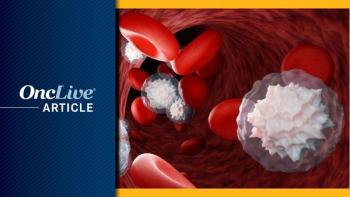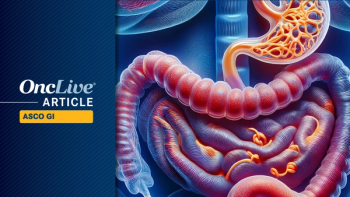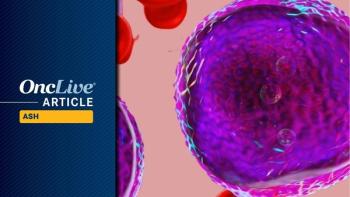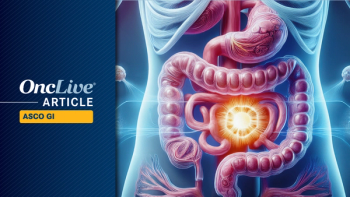
Acalabrutinib Combo Induces High Responses in CLL
Simultaneous targeting of Bruton’s tyrosine kinase and the CD20 antigen led to overall responses in more than 90% of patients with chronic lymphocytic leukemia, including untreated and relapsed/refractory disease.
Jennifer A. Woyach, MD
Simultaneous targeting of Bruton’s tyrosine kinase (BTK) and the CD20 antigen led to overall responses in more than 90% of patients with chronic lymphocytic leukemia (CLL), including untreated and relapsed/refractory disease, according to results from a small preliminary trial.1
Patients with previously untreated disease had an overall response rate (ORR) of 95%, declining slightly to 92% in patients with relapsed/refractory CLL when treated with the combination of acalabrutinib (Calquence) and obinutuzumab (Gazyva). Median duration of response had yet to be reached.
Patients with no prior treatment had a 39-month progression-free survival (PFS) of 94.4% and those with previously treated disease had a 42-month PFS of 72.7%, as reported at the 2019 ASCO Annual Meeting.
“Treatment with acalabrutinib plus obinutuzumab yielded high response rates that were durable and deepened over time in both relapsed/refractory and treatment-naïve patients,” said Jennifer Woyach, MD, of the Ohio State University Comprehensive Cancer Center in Columbus. “This combination was well tolerated in both cohorts, with low rates of grade 3 or higher adverse events (AEs) and grade 3 or higher bleeding, and only one case of atrial fibrillation. Most patients remain on treatment after a median follow-up of 3.5 years.”
BTK has an essential role in B-cell receptor signaling and has become a validated therapeutic target for CLL. In phase I/II clinical trials, the BTK inhibitor acalabrutinib achieved ORRs exceeding 90% as a single-agent therapy for patients with untreated and relapsed/refractory CLL.2-4 Obinutuzumab has approved indications for follicular lymphoma and untreated CLL.
Woyach reported findings from the 3-year follow-up of a single-arm trial involving 45 patients with CLL, 19 with untreated disease, and 26 with relapsed/refractory CLL. In the group with relapsed/refractory disease, prior treatment with a BTK inhibitor was allowed except in the case of discontinuation for on-treatment disease progression.
The study population had a median age of about 62, half had bulky disease, and only 1 patient had small lymphocytic lymphoma. About 20% had deletion 17p, a third had del(11q), most had unmutated IGHV, and about half had complex karyotype.
After a median follow-up of about 3.5 years, 78% of the patients remained on treatment. Woyach noted that 10 patients discontinued acalabrutinib, 5 because of AEw, 4 because of Richter transformation, 1 because of disease progression, and 1 patient died. All but 2 patients completed treatment with obinutuzumab.
The ORR in patients with previously untreated CLL consisted of complete responses (CRs) in 31.6% and partial responses (PRs) in 63.2%. In the relapsed/refractory group, 7.1% had CRs and 84.8% had PRs.
Woyach added that the complete response rate increased from 15% after 22 months, reflecting conversion from partial to complete responses in 3 patients. The median time to complete response was 18 months in the untreated patients and 12 months in the relapsed/refractory group. Median duration of response had yet to be reached in either group. At last follow-up visit, duration of response exceeded 90% in patients with untreated and relapsed/refractory disease.
With regard to minimal residual disease (MRD) status, 26% of previously untreated patients had MRD ≤0.01%, 21% had MRD >0.01 to <0.1%, and 42% had MRD >1%. One patient in the untreated cohort discontinued treatment, and none in the relapsed/refractory group.
The most common AEs (all grades) were upper respiratory tract infections (73%), weight gain (72%), maculopapular rash (66%), cough (64%), diarrhea (64%), headache (56%), nausea (54%), arthralgia (46%), dizziness (46%), constipation (45%), contusion (42%), fall (42%), infusion-related reaction (42%), sinusitis (42%), vomiting (42%), and fatigue (40%). The most common grade ≥3 AEs were neutropenia (24%); syncope (11%); decreased platelet count, cellulitis and weight gain (9% each); and hypertension and hypophosphatemia (7% each).
References
- Woyach JA, Rogers KA, Bhat SA, et al. Acalabrutinib with obinutuzumab (Ob) in treatment-naive (TN) and relapsed/refractory (R/R) chronic lymphocytic leukemia (CLL): Three-year follow-up. J Clin Oncol 37, 2019 (suppl; abstr 7500).
- Byrd JC, Harrington B, O’Brien S, et al. Acalabrutinib (ACP-196) in Relapsed Chronic Lymphocytic Leukemia. N Engl J Med 2016;374:323-332.
- Byrd JC, Weirda WG, Schuh A, et al Acalabrutinib Monotherapy in Patients with Relapsed/Refractory Chronic Lymphocytic Leukemia: Updated Results from the Phase 1/2 ACE-CL-001 Study. Blood 2017;130;498.
- Byrd JC, Woyach JA, Furman, RR, et al. Acalabrutinib in Treatment-Naive (TN) Chronic Lymphocytic Leukemia (CLL): Updated Results from the Phase 1/2 ACE-CL-001 Study. Blood 2018;132-692).

























































































